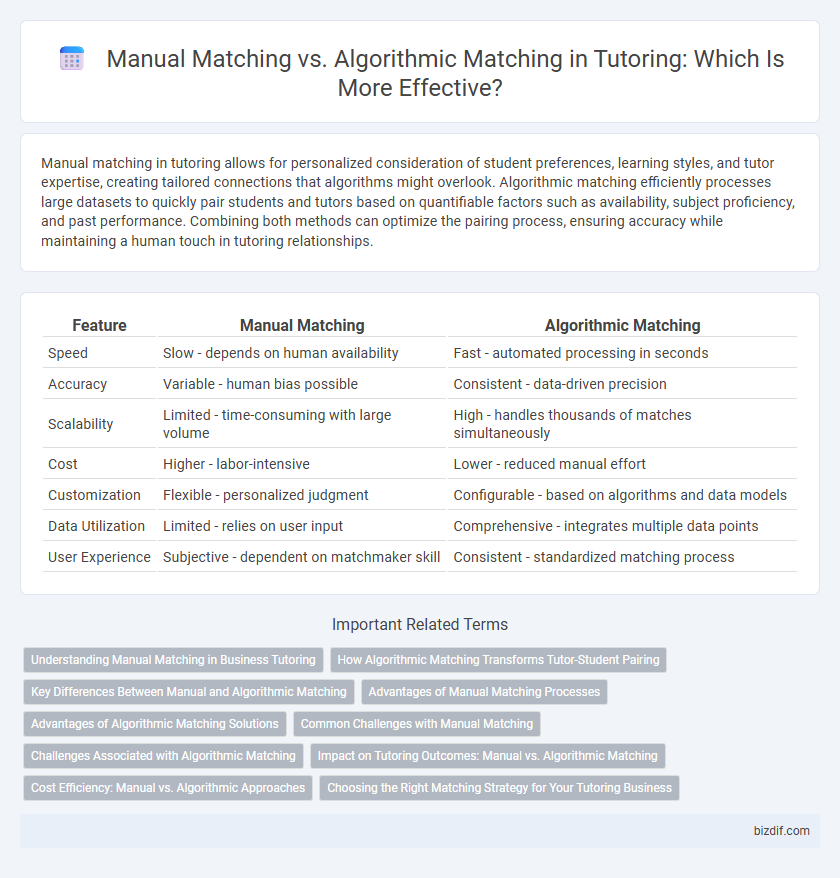Manual matching in tutoring allows for personalized consideration of student preferences, learning styles, and tutor expertise, creating tailored connections that algorithms might overlook. Algorithmic matching efficiently processes large datasets to quickly pair students and tutors based on quantifiable factors such as availability, subject proficiency, and past performance. Combining both methods can optimize the pairing process, ensuring accuracy while maintaining a human touch in tutoring relationships.
Table of Comparison
| Feature | Manual Matching | Algorithmic Matching |
|---|---|---|
| Speed | Slow - depends on human availability | Fast - automated processing in seconds |
| Accuracy | Variable - human bias possible | Consistent - data-driven precision |
| Scalability | Limited - time-consuming with large volume | High - handles thousands of matches simultaneously |
| Cost | Higher - labor-intensive | Lower - reduced manual effort |
| Customization | Flexible - personalized judgment | Configurable - based on algorithms and data models |
| Data Utilization | Limited - relies on user input | Comprehensive - integrates multiple data points |
| User Experience | Subjective - dependent on matchmaker skill | Consistent - standardized matching process |
Understanding Manual Matching in Business Tutoring
Manual matching in business tutoring involves personalized assessment of student needs and tutor expertise to create tailored learning pairs. This hands-on approach leverages human judgment to evaluate soft skills, subject comprehension, and teaching style compatibility, enhancing the quality of tutoring relationships. Despite requiring more time and resources than algorithmic matching, manual matching often leads to higher satisfaction and more effective learning outcomes.
How Algorithmic Matching Transforms Tutor-Student Pairing
Algorithmic matching leverages data-driven insights such as student learning styles, subject proficiency, and tutor expertise to create highly compatible tutor-student pairs. This method increases the efficiency and accuracy of matching by analyzing vast datasets and adapting to individual needs more precisely than manual selection. By optimizing compatibility, algorithmic matching enhances educational outcomes and student engagement in tutoring programs.
Key Differences Between Manual and Algorithmic Matching
Manual matching relies on human judgment to pair tutors and students, allowing for personalized consideration of learning styles and preferences but often consuming more time. Algorithmic matching utilizes data-driven algorithms to efficiently connect tutors and students based on factors like subject expertise, availability, and performance metrics. Key differences include scalability, speed, and consistency, with algorithms offering faster, standardized matches while manual methods provide nuanced, context-sensitive pairings.
Advantages of Manual Matching Processes
Manual matching processes in tutoring enable personalized tutor-student pairings by considering nuanced factors such as learning styles, personality compatibility, and specific educational needs that algorithms may overlook. This approach allows for human judgment in assessing soft skills and communication preferences, enhancing the effectiveness of the tutoring relationship. Furthermore, manual matching can adapt dynamically to unique cases, ensuring tailored support that improves student engagement and academic outcomes.
Advantages of Algorithmic Matching Solutions
Algorithmic matching solutions in tutoring leverage data-driven insights to pair students with the most suitable tutors based on learning styles, subject expertise, and availability, resulting in higher engagement and improved academic outcomes. These systems can process large volumes of profiles quickly, ensuring optimal matches that manual methods may miss due to human limitations and biases. Enhanced personalization and scalability make algorithmic matching a cost-effective, efficient approach for educational institutions and tutoring platforms aiming to maximize student success.
Common Challenges with Manual Matching
Manual matching in tutoring often leads to inefficiencies due to the time-consuming process of reviewing numerous tutor and student profiles. It frequently results in suboptimal pairings because human biases and limited data processing capacities impede accurate skill and learning style alignment. Furthermore, inconsistent matching criteria can cause variability in tutor-student compatibility, impacting the overall effectiveness of the tutoring experience.
Challenges Associated with Algorithmic Matching
Algorithmic matching in tutoring faces challenges including data accuracy, which directly impacts the effectiveness of pairing students with appropriate tutors. The complexity of personal learning preferences and varied subject expertise often results in imperfect algorithmic recommendations. Ensuring ongoing refinement of matching algorithms is essential to address biases and dynamic educational needs for optimized tutor-student collaboration.
Impact on Tutoring Outcomes: Manual vs. Algorithmic Matching
Manual matching in tutoring often relies on subjective judgment and personal connections, which can limit scalability and consistency in pairing students with suitable tutors. Algorithmic matching utilizes data-driven insights and machine learning models to optimize compatibility based on learning styles, subject expertise, and availability, significantly improving student engagement and achievement. Studies show algorithmic matching increases tutoring outcomes by 20-30% due to precise alignment of educational needs and tutor skills.
Cost Efficiency: Manual vs. Algorithmic Approaches
Manual matching in tutoring requires significant human resources, leading to higher labor costs and slower student-tutor pairing. Algorithmic matching leverages data-driven processes to quickly analyze student needs and tutor expertise, reducing operational expenses while improving scalability. Cost efficiency improves as algorithmic systems minimize manual intervention and optimize match accuracy.
Choosing the Right Matching Strategy for Your Tutoring Business
Manual matching allows personalized consideration of tutor expertise, student learning styles, and specific needs, ensuring tailored educational experiences. Algorithmic matching leverages data-driven analysis and machine learning to quickly pair students with tutors based on availability, subject proficiency, and past performance metrics. Selecting the right matching strategy depends on balancing scalability, accuracy, and the degree of customization required to optimize client satisfaction in your tutoring business.
Manual matching vs algorithmic matching Infographic

 bizdif.com
bizdif.com